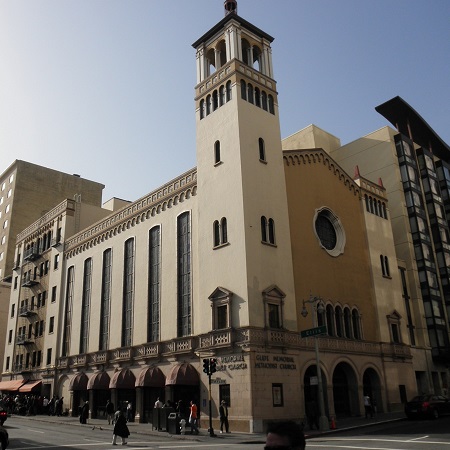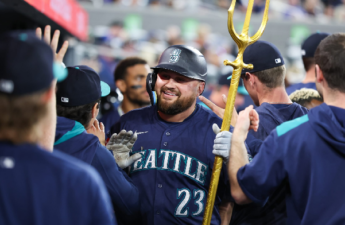When I worked at Glide in San Francisco, I worked with an intern from Germany on a project about the nature of Glide as an institution. It was a special project for the then CEO, newly hired, who wanted to study why Glide as an entity was so resistant to change and data despite being so effective at providing help for the poor and homeless of the city. The metaphor my co-worker came up with was a unicorn, which stood in for the mystical Glide culture that pervaded everyone’s image of Glide as a place and an institution in the community. Which is not to say that Glide isn’t a truly magical place, but that the image everyone had in their mind was that this more deeply magical than perhaps was real. And it came down to this unicorn that needed to be protected and sheltered, when it should actually be running free through the streets of the Tenderloin.
The issue is this: Glide became what it is (revolutionary, radically inclusive, a church without walls, a life-changing place) by taking risks, sometimes risking everything. This was easy to do at first because Glide was young and had nothing to lose. Glide was just an aging Methodist church in a decaying neighborhood when Cecil Williams arrived in the sixties and he had a vision that he was able to put into practice because he was totally unafraid of the consequences or the risks. This kind of fearless abandon is the heart of the unicorn, it was what was so downright inspiring about the early years of Glide, and it is what spawned such radical and amazing change and possibility.
But here’s the problem. The more success that this methodology encountered, the more success there was to build on within Glide as an institution. Over time, Glide was no longer just the fringe radical group that accepted gays and fed everyone. It acquired powerful friends like Maya Angelou and the Clintons and Warren Buffett. It acquired donors by the thousands, volunteers by greater thousands. It got government contracts, grants, and a certain institutional entrenchment that meant Glide suddenly had things to lose and thus to protect. No longer could Glide risk everything so freely because there was nothing to lose. Now there was influence and ability to lose, with thousands of San Franciscans relying on the services Glide could provide that was made possible in large part by these key connections and assets.
This success, this accumulation of power and influence and assets, this process makes institutions more conservative. And what the intern and I identified and proposed is that there is a tipping point where the component parts of the institution (staff) believe there is more to be potentially lost from the future than gained, and at or around that tipping point is when an institution goes from being idealistic and radical to protectionist and conservative. And the grand irony at Glide is that what everyone most wanted to protect was the mythical unicorn of Glide culture, whose every aspect was non-conformity, radicalism, inclusivity, and risk-taking. In other words, what everyone wanted to hunker down and preserve was the exact opposite of the attitude of hunkering down and preserving. And thus we presented our findings to an all-staff (or maybe all-manager?) meeting and started to put about a plan where Glide could both preserve its radicalism but become fluid and idealistic as it had always been and everyone always wanted.
I post this little vignette not to publicize somewhat internal information about Glide, an institution that I believe in fully and you should support, but because since doing this study in 2008, I have found the lessons of this understanding to be true about almost every institution everywhere. And not just institutions, perhaps, but people. It is complete cliche that the young are idealistic radicals and the old are cynical conservatives, but no one really analyzes why this is the case other than the shorthand that age creates conservatism. The older conservatives would argue this is because experience teaches you that conservatism is correct, but I think the flaw in this reasoning is obvious from the above. It’s not age itself, but the process of accumulating things that one fears losing. This is why the rich are more conservative than the poor, because they have more to lose. The entire spectrum of idealism can be measured by whether one fears the future more or finds it offering more hope. And that, in turn, is based entirely on what one feels one has to lose.
This is also why children are, in general, so wide-eyed and optimistic and idealistic. The future is where everything sits for children and, as a rule, even if they have things they don’t appreciate them fully because they can’t contrast it with the concept of not having them (unless, of course, they’ve experienced many different qualities of life over the course of their few years). Teenagers especially find the future and the immediate present to be vibrant with radiating possibility and freedom and thus take the most radicalism on. And by the time people are settled with jobs and relationships, suddenly the future looks like it’s coming for their stability more than offering more possibility. Doubly so if there are debts like student loans and mortgages to be paid.
Thus the challenge of the would-be idealist, the person who aspires to be King or Gandhi and reach much older age with idealism fully intact, is to be willing to take risks and not feel like there is much to be lost even if there are material things or stability to be lost in actuality. This, I suppose, is the heart of bravery and fearlessness, to act as though there’s nothing to lose even if there is, and is certainly what King and Gandhi called on from themselves and their supporters. Of course the lesson of those individuals precisely is that there is, indeed, everything to be lost, one’s own future time on this planet is completely at risk from behaving this way, yet both lived for years with the assassin’s bullet as a fully formed threat in the future and proceeded heedlessly and to great and wonderful effect.
Our society is a raging torrent of influences to get us to be more conservative, to fear the future, to hunker, bunker, and protect. The entire world of advertising, arguably the most powerful, constant, and influential voice in our world, tells us to fear this, that, or the other, and that only a product or service they are selling will mitigate the impending doom. Our news-media is a disaster-hound, teaching us to fear hurricanes and gunmen and people who don’t look like us who are coming for our stuff and our lives and our livelihoods. Our government, especially in the United States, is in endless paranoia about things being taken from a country the envisions itself as having absolute power, influence, and dominance, and thus absolutely everything possible to lose. This is why 9/11 can spawn the Patriot Act and war without end, because we are so darn afraid of losing anything that we flail hopelessly at the rest of the world for even thinking it could take anything from us, no matter how small that something is or overreactive our lashing out.
But there’s a reason that we idealize childhood, that being young is associated with joy and hope and the way we aspire to see the world. It’s because the world of the young is full of possibility and hope and a future that looks bright, whether or not it actually proves to be. Deep down, this is the way we all seek to live, the way we all know we should be living. We all have dreams that we’ve wanted to sacrifice for at some point. And it’s harder when the things we’re hunkering and bunkering to protect are marriages and children and the house with the white picket fence we’ve just agreed to pay off for three decades. And 100% risk is not for everyone. But I think examining your own calculus of more-to-gain or more-to-lose from the future is a great guidepost to looking at your own idealism and getting back to a place where the future is pregnant with possibility, not portentous with loss.
Certainly the institutions in which we interact, work, and play could learn a lot from this. But that starts with each of us being idealistic enough to take those chances and inspire others to do the same. Only then are we really living, are we really free, and are our unicorns real.



